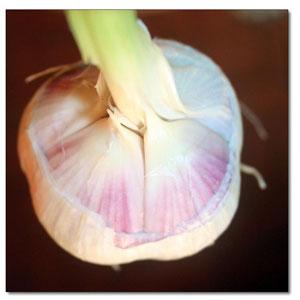|
|
The garlic-salt connectionby Ari LeVaux Freshly dug garlic is a beautiful thing. It has a vibrant, youthful shine to it and cloves that are enclosed in fleshy wrappers that have not yet dried into paper. Flavor wise, new garlic is a different animal, too. When raw, it sizzles hotter on the tongue than its mature, cured counterpart. Cooked, its pearly white glow turns to watery translucence, as the flavor becomes candy-sweet. The garlic harvest runs from about now until midsummer, and if you can get your hands on some freshly pulled stuff, still attached to the plant, there are many ways to celebrate the occasion. Since it happens that the seasons for both new garlic and backyard grilling coincide, I think a discussion of garlic-based marinades should not be delayed. The first step in a good garlic marinade is to crush the cloves with salt. I learned this technique in Brazil, but have since realized it’s an Old World trick that has found its way to many corners – basically anywhere they have mortars, pestles, salt and garlic. From Puerto Rican pinchos to Haitian griot to Texas-style mojo, to Moroccan harissa, mashing garlic and salt seems to have caught on wherever it went – probably because once you start doing it, you don’t ever want to quit. Any time you’re smashing, chopping or otherwise deconstructing garlic, a little salt will usually help. If you’ve mashed garlic before, you know it can be unwieldy, squirting across the room under pressure. Even just a little bit of salt changes that. The pestle (or blade, or baseball bat) gets better friction when it strikes the garlic if there’s salt around. The garlic bruises and fractures more readily because of the salt, which draws moisture from the cells. The cloves collapse into paste – or in the case of moist, new garlic, a slurry. In the interior of Bahia state, in northeastern Brazil, a vegetarian cook named Jeu taught me the ways of mashed garlic and salt. Jeu’s crew, in their heavy Afro-Baiano slang, called it alho machucado, which translates to something like “beat-up garlic,” but it has many names. The garlic that grows in the tropics tends to be small and packed with numerous miniscule cloves covered in wispy paper that sticks to your fingers. Every week or two, some poor prep cook in Jeu’s kitchen would have to peel a mountain of these tiny cloves. Afterward, the garlic was mashed with salt in a huge mortar until there was enough to fill a two-quart jar, which was kept in the fridge and dipped into frequently during the preparation of most meals. Almost every dish began with a dollop of alho machucado in the bottom of a big, dented aluminum pan. Amazingly, this was done in the absence of oil. How much salt to add is a personal choice that’s dependent on many variables, including how strong the garlic is, what form of salt you have, and your personal taste. With spicy new garlic fresh from my garden and coarse Mediterranean sea salt, I’ve been using about 1 or 2 tablespoons garlic to 1 teaspoon salt. I usually suggest slicing garlic gloves before mashing them, but new garlic is especially susceptible to salt, and big cloves crush like butter. It really helps to have a solid mortar and pestle for these techniques. Sure, you can wing it once in a while with a beer bottle on a cutting board, but when you have the right tool you’ll really understand why the technique is so popular. I recommend the big heavy stone kind. Simple alho machucado is a great marinade rub for meat, even for just a few minutes but ideally overnight. And a whole range of more complex marinades begin with the mashing of garlic and salt. For Puerto Rican pinchos, or meat skewers, oregano, black pepper, vinegar and olive oil are mixed with the garlic salt paste, while for Cuban-style pinchos the garlic, salt and pepper are joined with citrus juice. Whatever acid and herbs you use, these garlic- and salt-based rubs are basically awesome on all meats and some veggies too, like potatoes, zucchini and eggplant. I make a New Mexico-style mashed garlic and salt marinade in which I add peppercorns, dried oregano, lime, olive oil and lots of mild red chile powder to the garlic salt paste, and mash it all together. Not only does it season meat, but it’s also the basis for a great sauce when added to frying onions in the pan, along with some water. I like to poach, steam or scramble eggs in that sauce, which results in something like huevos rancheros. The garlic harvest will be gone as quickly as it arrives, so go find yourself some new garlic and experience what it can do for your marinade. The farmers market is the best place for garlic hunting, and you can often find new bulbs for sale still attached to the plant. Of course, even after this year’s garlic crop is cured and matured, you can mash garlic with salt all year long to your heart’s content. But now, during the harvest, is the ideal time to buy garlic, both for eating and for storing and perhaps for planting this fall if you’re so inclined. If the garlic at your local farmers market looks good, then you know it should grow well in your area. And this time next year you could be pulling, and mashing, your own. |


